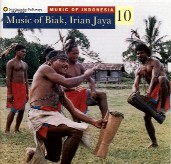|
Music of Biak, Irian Jaya. Music of Indonesia, vol. 10. Recorded and compiled by Philip Yampolsky. 72 mins. Liner notes 25 pp. Produced in collaboration with the Indonesian Society for the Performing Arts. Smithsonian Folkways LC9628, 1996. |
They situate Biak in a long history of encounters with outsiders from Europe and other parts of Indonesia—a history that continues to unfold as Biak has become one of the main ports of entry by air to Indonesia for travelers from North America. |
|
The authors chose to focus on three genres: two contemporary types of song are contrasted with the older wor (Audio 1), which the authors characterize as a genre that is “in decline” but is still remembered by many. |
|
The two newer genres, yospan and church songs, which have largely replaced wor at celebrations, display ample foreign influence. My comments will be limited to impressions of the contrasting sound of these three genres. Most of the album is devoted to wor. Seventeen of the twenty-two tracks exemplify this genre. Divided into dance, non-dance, and narrative categories, they supply a richer representation of this genre than most listeners will probably want or need. Characterized by choral singing (almost exclusively male on these tracks) and drumming, the differences between one track and the next are not consequential for the uninitiated ear. But the wealth of contextual information provided for these songs enables one to appreciate some of their significance. The men form into two opposing choruses that compete for attention, one group “beginning their verse before the [other] singers are finished, and the [other] singers retaliating to ‘steal back’ the song” (liner notes, p. 6). Within each group singers also strive to stand out. Rutherford and Yampolsky note the emphasis on variation, the importance of travel, and the incorporation of foreign experience. |
|
The four examples of church songs (Audio 2) offer a stunning contrast to the wor: sung in five part harmony by female choirs, these performances are evidence of the deep influence of Christianity and the long reach of European missionary and colonial power. Sonically beautiful, these tracks closely resemble Christian choral singing from various areas of Africa and other parts of the world. |
|
sample |
Yospan (Audio 3), represented by a medley of four songs in the final track on this album, is a recent dance genre, created from two other types of dance, one fast and one slow. The fascinating history of this hybrid involves government policy, imitations of Dutch warplanes, and various other seemingly incongruent elements. |
The dance has apparently become the centerpiece of celebrations. It is accompanied by an ensemble of guitars, homemade ukuleles and drums, and a giant  bass guitar, the strings of which are
beaten with a stick. This is an amateur form of expression that is open to all members of
Biak society. The authors offer a highly engaging account of the fluidity of the dance and
the way that virtually any element can be absorbed into it. They end with the intriguing
claim that “wor and yospan are based on the same resilient principles. In a
conventional framework of words (wor) or motions (yospan) both present the foreign as a
startling source of inspiration to be mobilized and circulated locally. Both genres embody
the aesthetic of surprise” (liner notes, p. 14). bass guitar, the strings of which are
beaten with a stick. This is an amateur form of expression that is open to all members of
Biak society. The authors offer a highly engaging account of the fluidity of the dance and
the way that virtually any element can be absorbed into it. They end with the intriguing
claim that “wor and yospan are based on the same resilient principles. In a
conventional framework of words (wor) or motions (yospan) both present the foreign as a
startling source of inspiration to be mobilized and circulated locally. Both genres embody
the aesthetic of surprise” (liner notes, p. 14). |
|
introduction | vol
10 | vol 12 | conclusion |
|
